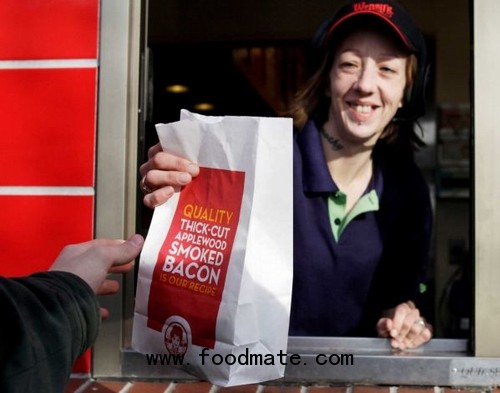
Wendy's push to remake itself as a higher-end hamburger chain is starting to pay off, with a key sales figure rising for the sixth straight quarter.
The company, based in Dublin, Ohio, is trying to pull away from the image of the typical fast-food chain and cast itself as a purveyor of higher-quality burgers and sides. The move reflects the growing popularity of chains such as Chipotle and Panera, which offer better quality food for slightly higher prices.
Other chains have been taking cues from the new breed of fast-casual restaurants as well, with Burger King reworking its menu and Taco Bell rolling out its higher-end Cantina Bell bowls and burritos earlier this year. McDonald's Corp., meanwhile, said it plans to intensify its focus on value in the challenging economy. The Oak Brook, Ill.-based chain said Thursday that sales in October fell for the first time since 2003.
In the latest quarter, Wendy's said premium food offerings — such as the Son of Baconator and the Asiago Ranch chicken sandwich — helped lift revenue by 2.7 percent at restaurants open at least 15 months. That marks the sixth straight quarter that figure has climbed. The figure is a good gauge of a restaurant chain's health because it strips out the volatility of newly opened and closed stores. Wendy's said the increase was driven by greater spending per visit, although the number of transactions declined.
The improvement helped Wendy's shares rise 13 cents, or 3 percent, to close at $4.39.
CEO Emil Brolick said in a conference call with analysts that Wendy's can keep improving the image of its food without paying that much more for ingredients. For example, Wendy's is considering different bread options such as wheat or focaccia buns for its burgers and sandwiches. Even though these wouldn't cost Wendy's much more, Brolick has said customers equate them with better quality and are willing to pay more for them.
He noted Thursday that it was the "perceived quality" that customers care about — not the actual ingredients.
"We believe we can be more astute about that than we have been in the past," he said.
Another big part of Wendy's transformation is the remodeling of its outdated restaurants with a more modern, inviting look. Brolick, who was hired about a year ago, says that new look is needed to signal the chain's transformation to customers, as well as justify the higher prices. The look, which has a variety of seating options, light wood and flat-screen TVs, is intended to make people feel that they can relax to enjoy their meal — not unlike the atmosphere at Panera.
Wendy's said it plans to accelerate remodeling of company-operated restaurants in the months ahead and recently introduced an incentive program to entice franchisees to remodel. Starting in March, it's also rolling out the first update to its logo since 1983.
For the three months ended Sept. 30, Wendy's reported a bigger loss, in part because of a charge related to the early payoff of debt. It lost $26.2 million, or 7 cents per share. It posted a loss of $4 million, or a penny per share, a year ago when it incurred costs related to the spinoff of the Arby's chain.
Not including one-time items, Wendy's said it earned 3 cents per share. Analysts expected 5 cents.
Total revenue rose 4 percent to $636.3 million, which also fell short of the $640.6 million Wall Street expected.
The company declared an increase in its quarterly dividend to 4 cents per share from 2 cents per share.
The Wendy's Co. has more than 6,500 restaurants, primarily in North America.





